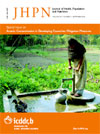
|
The Journal of Health, Population and Nutrition
icddr,b
ISSN: 1606-0997
EISSN: 1606-0997
Vol. 36, No. 1, 2017, pp. 1-13
|
 Bioline Code: hn17043
Bioline Code: hn17043
Full paper language: English
Document type: Research Article
Document available free of charge
|
|
|
The Journal of Health, Population and Nutrition, Vol. 36, No. 1, 2017, pp. 1-13
| en |
Gender differences in hypertension awareness, antihypertensive use and blood pressure control in Bangladeshi adults: findings from a national cross-sectional survey
Rahman, Muntasirur; Williams, Gail & Mamun, Abdullah Al
Abstract
Background: Bangladesh is facing an epidemiological transition with a growing burden of non-communicable
diseases. Traditionally, hypertension and associated complications in women receive less recognition, and there is a
dearth of related publications. The study aims to explore gender differences in high blood pressure awareness and
antihypertensive use in Bangladeshi adults at the community level. Another objective is to identify factors associated
with uncontrolled hypertension among antihypertensive users.
Methods: Data from the Bangladesh Demographic and Health Survey (BDHS 2011) was analysed. From a nationally
representative sample of 3870 males and 3955 females, aged ≥35 years, blood pressure and related information were
collected following WHO guidelines. Logistic regression models were used to estimate adjusted odds ratio (AOR) for
factors affecting blood pressure awareness, antihypertensive use and uncontrolled hypertension among males
and females taking antihypertensive medications. All analyses were weighted according to the complex survey
design.
Results: Women were more likely to have their blood pressure measured (76% vs. males 71%, p < 0.001) and to
be ‘aware’ about their own high BP (55% vs. males 43%, p < 0.001). No gender difference was observed in antihypertensive
medication use among those who were aware of their own high BP (females 67%, males 65%, p = 0.39). Nonworking
females were less likely to use antihypertensive (67% vs. non-working males 77%, p < 0.05). Poor women were
worse off compared with poor males in antihypertensive medication use. One-in-three antihypertensive medication users
had stage 2 hypertension (SBP ≥160/DBP ≥100 mmHg). Female sex, older age, increased wealth, higher BMI and certain
geographical regions were associated with poor blood pressure control among antihypertensive medication users.
Conclusions: BP check-ups and hypertension awareness were higher among women than men but did not translate
into better antihypertensive medication practice. Gender disadvantage and inequity were observed in antihypertensive
medication use. Our findings reiterate the importance of sex-disaggregated analysis and reporting. Policy makers should
explore the uncontrolled hypertension burden and geographical variations in Bangladesh.
Keywords
Blood pressure; Hypertension; Awareness; Gender; Public health
|
| |
© Copyright 2017 - The Author(s)
Alternative site location: http://www.jhpn.net
|
|
